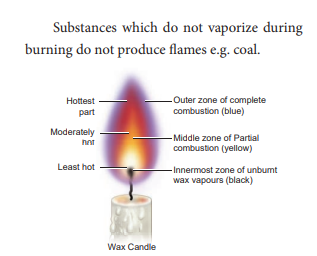
PUMPA - SMART LEARNING
எங்கள் ஆசிரியர்களுடன் 1-ஆன்-1 ஆலோசனை நேரத்தைப் பெறுங்கள். டாப்பர் ஆவதற்கு நாங்கள் பயிற்சி அளிப்போம்
Book Free DemoFlame
A zone in which combustion of combustible substances occurs is called flame.
The substances which vaporize while burning give flames. For example, kerosene, wax, etc.
The substances that do not vaporise while burning do not give flames. For example, coal.
Flame is a mixture of gases (vaporised fuel, oxygen, carbon dioxide, carbon monoxide, water vapour, and many volatile materials). The flame produces energy (i.e., heat and light). The flame is not a matter, but fire is a matter.
Flame is a chemical reaction.
Structure of a flame:

Structure of flame
Image credits: TNSB class 7 Unit 4 (Chemistry in everyday life)
Flame consists of three zones:
1. Outer zone: Perfect combustion of the fuel occurs in the outer zone. The colour of the flame is blue, and it is the hottest part and non-luminous.
2. Middle zone: Incomplete combustion of the fuel occurs in the middle zone. The colour of the flame is yellow, and it is medium hot and luminous.
3. Inner zone: Unburnt combustion of the fuel occurs in the inner zone. The colour of the flame is black, and it is the least hot part.
Flame is always upwards. Why?
Burning vapours above the candle cause the flame, and the burning vapours are hotter compared to the surrounding air; hence its density is less. So, according to the principle of convection, the flame is always upwards.
Reference:
file:///C:/Users/User/Desktop/Books/7th_Science_EM/7th_Science_Term_III_EM_www.tntextbooks.in.pdf